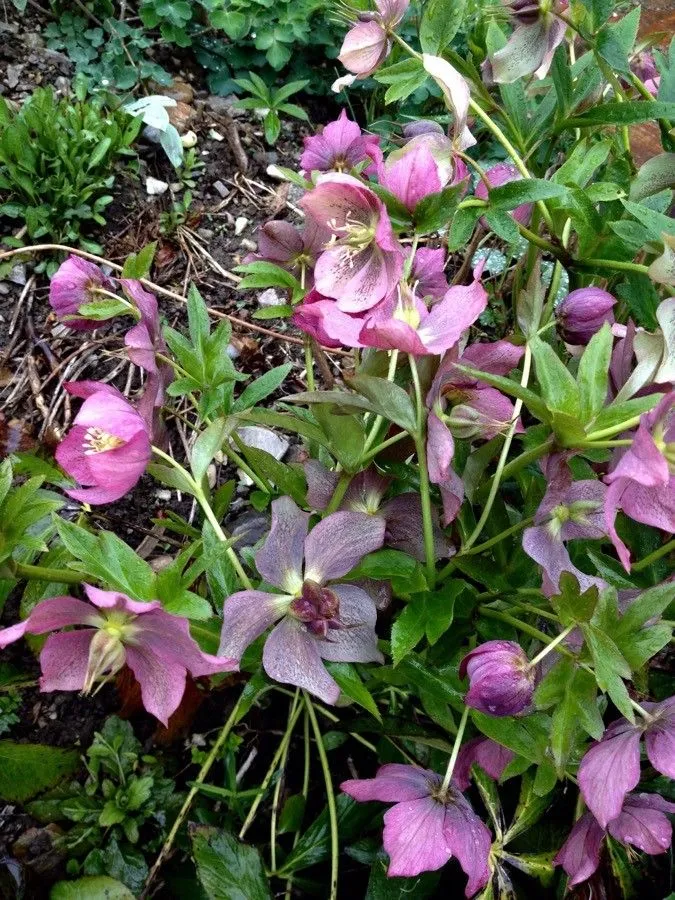
Author: Lam.
Bibliography: Encycl. 3: 96 (1789)
Year: 1789
Status: accepted
Rank: species
Genus: Helleborus
Vegetable: False
Observations: NE. Greece to Caucasus
The Lenten-rose, scientifically named Helleborus orientalis, is a perennial flowering plant renowned for its captivating beauty and early blooming period. Found naturally from northeastern Greece stretching to the Caucasus region, this species thrives in woodland environments and shaded garden settings.
First described in 1789 by the botanist Jean-Baptiste Lamarck, Helleborus orientalis belongs to the Ranunculaceae family, commonly known as the buttercup family. This group includes many plants that are prized for their ornamental value and distinctive floral characteristics. The Lenten-rose, in particular, is cherished for its resilience during the latter part of winter and early spring when few other plants are in bloom.
The flowers of the Lenten-rose are particularly notable for their unique structure and rich colors. They typically exhibit a range of hues from white, pink, and deep purple to almost black, sometimes adorned with delicate spotting or veining. Unlike many flowers, the petals of Helleborus orientalis are actually modified sepals, which remain on the plant for several months, giving it an extended period of visual interest.
In addition to its aesthetic appeal, Helleborus orientalis is valued in gardens for its evergreen foliage. The leaves are dark green, divided into multiple leaflets with serrated edges, providing a lush backdrop throughout the year. This persistent greenery makes it an excellent ground cover and understory plant in wooded garden areas.
Cultivating Lenten-roses requires attention to a few key growing conditions. These plants prefer well-drained, humus-rich soil and flourish in partial to full shade. They are relatively drought-tolerant once established but benefit from regular watering during dry spells to ensure continuous growth and flowering. Gardeners should be mindful, however, that all parts of the Helleborus orientalis plant are toxic if ingested, so it is advisable to handle them with care and plant them away from areas accessible to pets and children.
The Lenten-rose’s early bloom period and hardiness make it an invaluable addition to any garden looking to bridge the gap between winter and spring with enduring blooms and robust foliage. Holding historical significance within the botanical community and continuing to enchant gardeners worldwide, Helleborus orientalis stands out as a timeless favorite amongst shade-loving perennials.
Deu: garten-nieswurz, orient-nieswurz, orientalische nieswurz
Eng: lenten-rose
Dan: storblomstret julerose
Fra: hellébore d’orient
Swe: turkisk julros, orientalisk julros, röd julros
Nno: raud julerose
Nob: rød julerose
Cym: crafanc-yr-arth y grawys
En: Lenten-rose, Lenten hellebore, Oriental hellebore
Ar: خربق مشرقي
Bg: Розов кукуряк
Zh: 東方聖誕玫瑰
Da: Pæskeklokke, Påskeklokke, Storblomstret julerose
Nl: Lenteroos
Eo: Orienta heleboro
Et: Kaukaasia lumeroos
Fi: Idänjouluruusu
Fr: Hellébore d’Orient, Rose de carême
De: Orientalische Nieswurz, Lenzrose, Garten-Nieswurz, Orient-Nieswurz
Ml: ഹെല്ലെബോറസ് ഓറിയൻറാലിസ്
Nb: Rød julerose
Nn: Raud julerose
Sv: Turkisk julros, Orientalisk julros, Röd julros
Cy: Crafanc-yr-arth y grawys
Taken Mar 12, 2019 by Dieter Wagner (cc-by-sa)
Taken Apr 17, 2019 by Dieter Wagner (cc-by-sa)
Taken Apr 17, 2019 by Dieter Wagner (cc-by-sa)
Taken Mar 19, 2019 by John Halderman (cc-by-sa)
Taken Apr 17, 2019 by Dieter Wagner (cc-by-sa)
Taken Feb 11, 2019 by Annemarie Ahrens-Stehle (cc-by-sa)
Taken Mar 7, 2022 by Kai Best (cc-by-sa)
Taken Nov 22, 2021 by Annemarie Ahrens-Stehle (cc-by-sa)
Taken Nov 24, 2021 by Annemarie Ahrens-Stehle (cc-by-sa)
Taken Jan 7, 2022 by Annemarie Ahrens-Stehle (cc-by-sa)
Taken Feb 5, 2022 by Jacques Zuber (cc-by-sa)
Taken Feb 18, 2021 by Sabina Hartmann (cc-by-sa)
Taken Mar 27, 2022 by alchemIlla (cc-by-sa)
Taken Mar 29, 2019 by Dieter Wagner (cc-by-sa)
Taken Apr 17, 2019 by Dieter Wagner (cc-by-sa)
Taken Mar 10, 2022 by Frédéric Faure (cc-by-sa)
Taken Mar 20, 2022 by Else Nolden (cc-by-sa)
Taken Feb 27, 2022 by Else Nolden (cc-by-sa)
Taken Feb 27, 2022 by Else Nolden (cc-by-sa)
Taken Jan 8, 2019 by Dieter Wagner (cc-by-sa)
Taken Mar 11, 2015 by Tela Botanica − Jean-Claude CALAIS (cc-by-sa)
Taken Mar 23, 2015 by Tela Botanica − Liliane Roubaudi (cc-by-sa)
Taken Mar 11, 2015 by Tela Botanica − Jean-Claude CALAIS (cc-by-sa)
Taken Jan 9, 2020 by robin niel (cc-by-sa)
Taken Mar 23, 2015 by Tela Botanica − Liliane Roubaudi (cc-by-sa)
© copyright of the Board of Trustees of the Royal Botanic Gardens, Kew.
© copyright of the Board of Trustees of the Royal Botanic Gardens, Kew.
© copyright of the Board of Trustees of the Royal Botanic Gardens, Kew.
Taken May 11, 2021 by Dieter Albrecht (cc-by-sa)
Taken Apr 27, 2021 by Nicole Beaudeur (cc-by-sa)
Taken Apr 5, 2021 by Sean Mayfield (cc-by-sa)
Taken Jan 9, 2020 by robin niel (cc-by-sa)
Taken Apr 10, 2020 by bauduin.ben (cc-by-sa)
Growth habit>: Forb/herb
Family: Myrtaceae Author: (F.Muell.) K.D.Hill & L.A.S.Johnson Bibliography: Telopea 6: 402 (1995) Year: 1995 Status:…
Family: Rubiaceae Author: Pierre ex A.Froehner Bibliography: Notizbl. Bot. Gart. Berlin-Dahlem 1: 237 (1897) Year:…
Family: Sapindaceae Author: Koidz. Bibliography: J. Coll. Sci. Imp. Univ. Tokyo 32(1): 38 (1911) Year:…
Family: Asteraceae Author: A.Gray Bibliography: Pacif. Railr. Rep.: 107 (1857) Year: 1857 Status: accepted Rank:…
Family: Fabaceae Author: Medik. Bibliography: Vorles. Churpfälz. Phys.-Ökon. Ges. 2: 398 (1787) Year: 1787 Status:…
Family: Aspleniaceae Author: (Cav.) Alston Bibliography: Bull. Misc. Inform. Kew 1932: 309 (1932) Year: 1932…